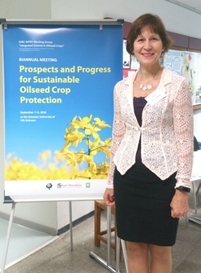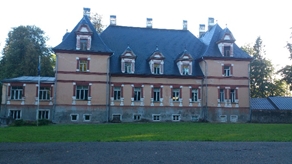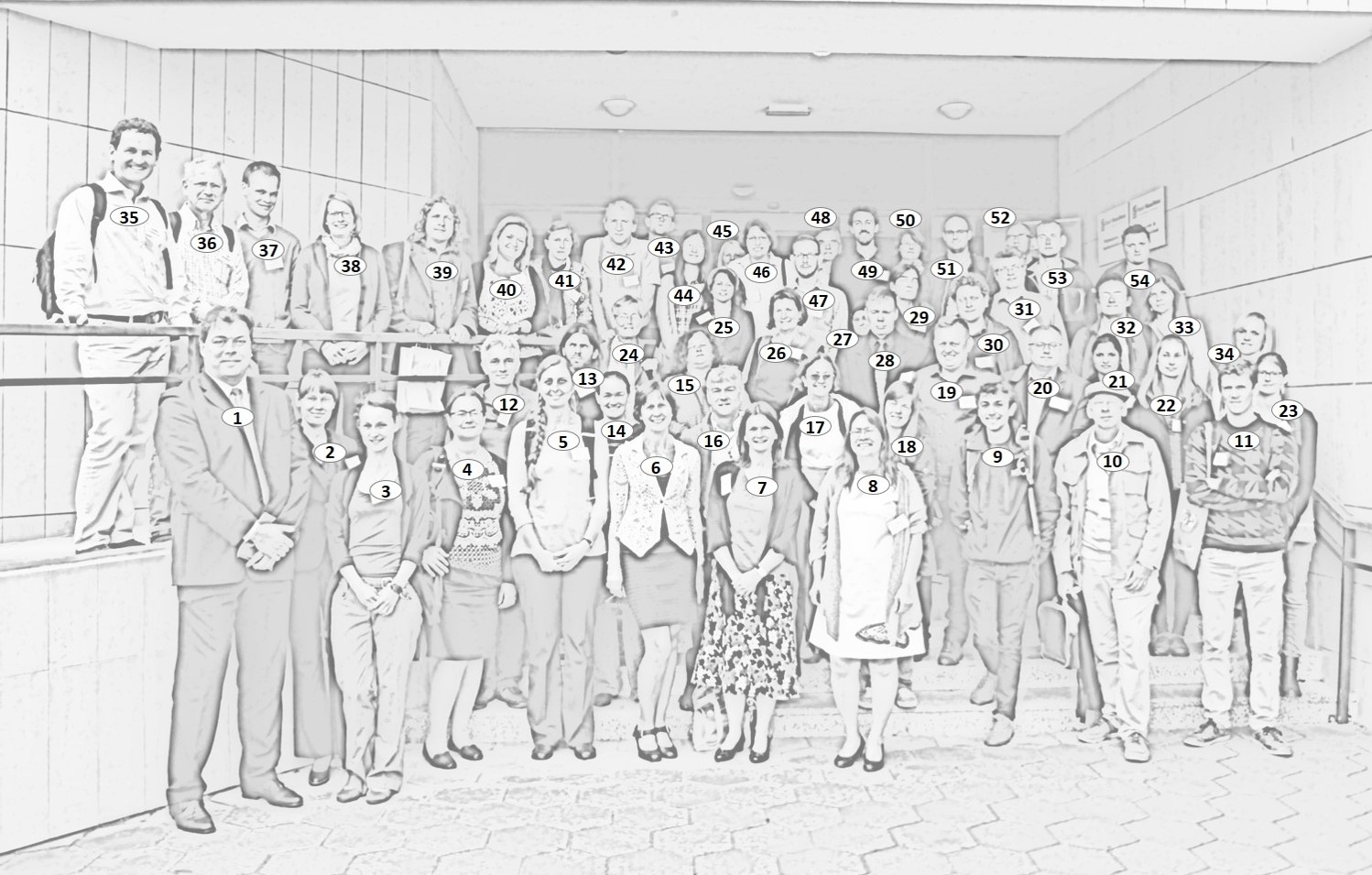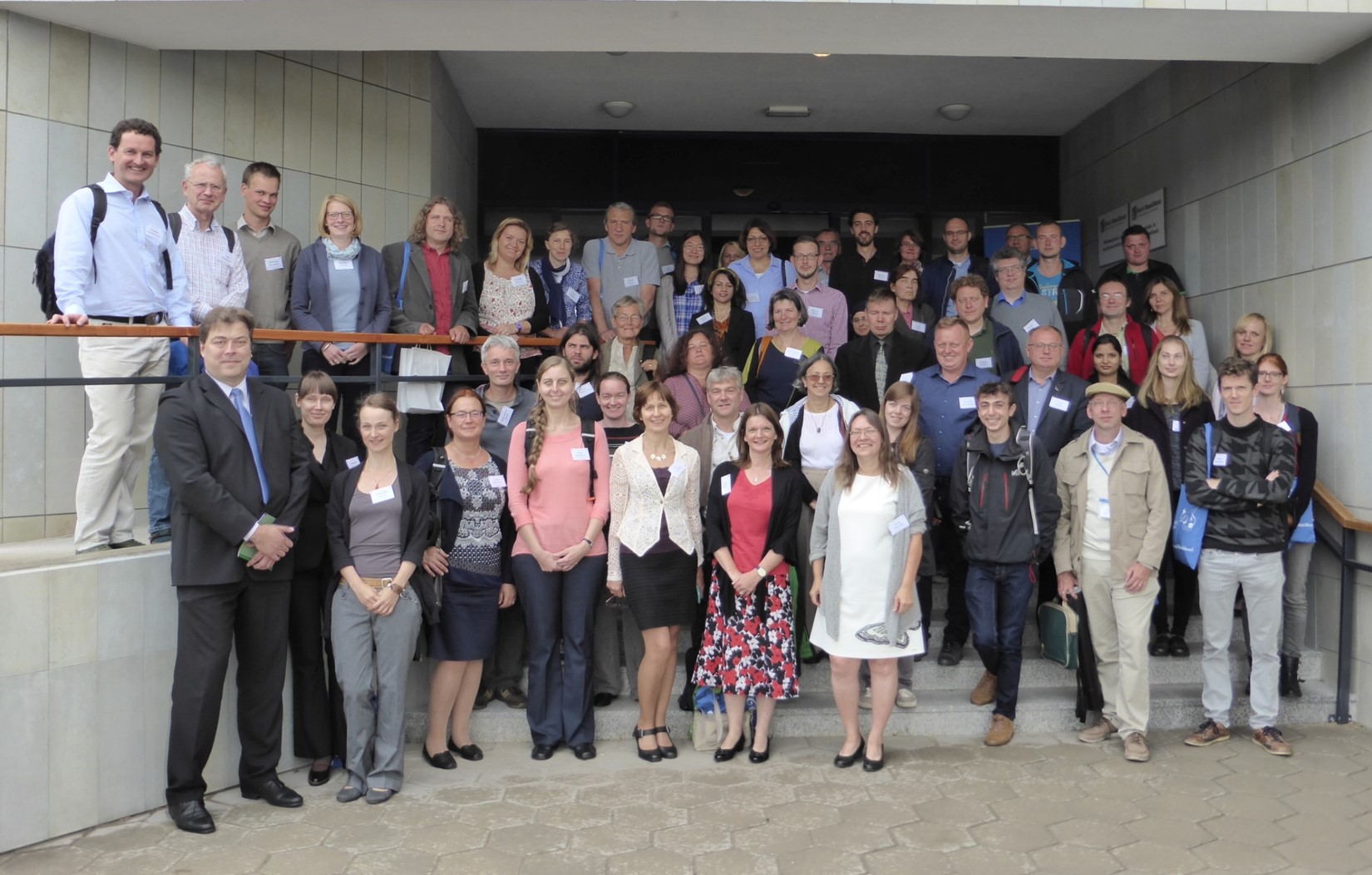WG meeting 2016 in Tartu, Estonia

This meeting was held 7-9th - September 2016 at the Estonian University of Life Sciences in Tartu, Estonia. Eve Veromann and her colleagues were the local organizers and did a wonderful job. Thank you very much on behalf of all the group for your hard work! Sponsorship was kindly provided by the Estonian University of Plant Sciences and the Estonian Society of Plant Protection. Also, Eesti Loodusfoto Publishers provided wonderful books on Estonian conservation areas for all speakers which were highly appreciated by everyone!.

The head of the local organizing team: Dr. Eve Veromann
This was our biggest meeting ever and we consider it one of our most successful! In total 60 participants from 10 European countries attended the meeting. Participants originated from Belgium, Croatia, Czech Republic, Estonia, France, Germany, Luxembourg, Poland, Switzerland and the United Kingdom.
Altogether there were 57 presentations (42 oral & 15 posters) given during the three days of our meeting. There was lots of time in both sessions for discussion and the relaxed and friendly atmosphere stimulated intense scientific exchange... with two emerging ideas for EU proposals!
We had two General sessions and concurrent Entomology and Pathology sessions. Of the General sessions, one discussed insect-mediated disease and the possibility of using Arabidopsis for model system for OSR research and the other focussed on the prospects for entomopathogenic fungi in bio-control of OSR Pests.
The Entomology subsection had 4 sessions.
In Session 1 (chairs: Sam Cook & Michael Eickermann) we discussed insecticide efficacy, side effects and new alternatives (e.g. development of RNAi approaches). Efficacy of insecticides against oilseed rape pests across Europe continues to be reduced via resistance: Myzus persicae, pollen beetle, cabbage seed weevil, cabbage stem flea beetle and rape winter stem weevils are now affected. Effects on non-targets - especially biocontrol agents - also requires careful monitoring, and it appears that some insecticides and application techniques (e.g. dropleg) have less damaging effects than others on beneficials - offering possibilities for IPM.
In Session 2 (chair Eve Veromann) we discussed work to improve decision support for IPM: helping farmers to treat crops only when necessary by on-line tools to improve the accuracy of timing crop monitoring and models and tools to help predict whether or pest abundance will reach threshold.
In session 3 (chair Bernd Ulber) we had presentations on delivering effective control of OSR pests via natural enemies. Natural pest control services were valued highly by a panel of experts and it was found that nitrogen fertilization can affect parasitism rate, as can the proximity of OSR fields to grasslands.
In Session 4 (chair: Udo Heimbach) we heard about advances towards breeding for resistance to insect pests. Work is progressing to identify genotypes and traits of tolerance/resistance to pollen beetles, cabbage stem flea beetle cabbage root fly. Development of effective screening methods is the first barrier to overcome but there are promising developments. Previous work on cabbage seed weevil previously found Sinapis alba was resistant. Introgression lines (S. alba x B. napus) were produced and the mechanisms for resistance found to be mainly antibiotic - via reduced survival/development of the larvae. Resistant cultivars are a keystone in IPM strategies, so we keenly await further developments in this exciting area!
The Pathology subsection
Plant pathology sub-section of the biannual meeting was divided to four sessions, of which two were devoted to blackleg, one full session was on clubroot and one session concentrated on non-chemical methods of disease control.
Blackleg, or stem canker, caused by Leptosphaeria maculans has become one of the major diseases of oilseed rape worldwide, primarily on winter form of this crop. Three presentations, from Germany, Poland and Czech Republic, focused on the resistance to blackleg, especially the assessment of the efficiency of major resistance genes, the production of interspecific hybrids of Brassica family resistant to the disease and the induction of resistance against the pathogen using collagen and keratin hydrolysates. The other topic was the distribution, severity and chemical control of blackleg. The UK research teams reported new virulent races of L. maculans populations and found out that the resistant reaction depends on the temperature. They have also pointed out the importance of L. biglobosa, the species previously described by some research teams as low or non-pathogenic. The distribution of both Leptosphaeria species was studied in detail in in the Czech Republic at the country-wide scale. German team evaluated the variability on fungicide sensitivity of L. maculans and L. biglobosa. Additionally the same team studied the effects of fungicides and different plant growth regulators on blackleg symptoms and the yield of winter oilseed rape treated and untreated with these preparations.
One session was devoted to clubroot, a damaging disease of winter and spring form of oilseed rape, worldwide. The disease is caused by Plasmodiophora brassicae, the pathogen representing the infrakingdom of Rhizaria. The incidence and pathotypes of the pathogen were studied in the Czech Republic, Poland and Germany, with the latter team working on pathogen suppression using soil amendments. The Polish team reported the use of the plant-host molecular regulatory networks by the pathogen for feeding itself in plant tissues and first results on proteomic approach to study cell wall changes occurring within host plant during clubroot infection. Due to the fast development of clubroot symptoms on oilseed rape in many countries we presume that sessions on clubroot will be continued in the future.
At the biannual meeting in Tartu we also concentrated on non-chemical ways of disease control. The research team from Poland presented the potentials of Trichoderma strains for control of blackleg. The studies were done in the laboratory conditions as well as in the field. Several species of Trichoderma affected the disease development so their defense potential can be used to supplement the other, non-chemical ways of disease control. Antagonistic fungi were also used by another Polish team to partially control Sclerotinia stem rot. In France, numerous isolates of S. sclerotiorum developed resistance to SDHI fungicides and a few ways of managing this situation were demonstrated. Further studies performed in Poland evaluated the effect of crop rotation and the time of fungicide application on disease severity in winter oilseed rape. Moreover, the impact of crop rotation and cultivation systems on weeds was also presented. Many diseases of winter oilseed rape can also sustain on weeds, so weed control is an important part of integrated disease control. The effect of different nutrition and growth stimulation programs on fluorescence of chlorophyll a and gas exchange efficiency in leaves of oilseed rape were also demonstrated. A big problem in Scotland in winter oilseed rape is the light leaf spot, caused by the fungus Pyrenopeziza brassicae. Scottish team presented integrated management strategies for controlling the disease.
The only presentation on the disease of an oilseed crop other than oilseed rape concerned pasmo of linseed. Symptoms of this disease were observed in France. It was very disturbing to find pseudothecia of Mycosphaerella linicola on linseed stubble, what points out the occurrence of the generative stage of the causal pathogen and its potential harmfulness.
Sociability
We worked hard - but we had lots of fun too! Our conference dinner was at the Mooste Distillery (www.viinavabrik.ee) . We had a funny guided tour of the manor house and between courses of a delicious meal we enjoyed Estonian traditional folk music and dance - with audience participation!!!

Mooste Distillery
Finally, we successfully laid plans for organizing the next Working Group meeting. Ivan Juran offered to host the next WG meeting at the University of Zagreb, Croatia in September 2018. We all agreed this is a beautiful country and an amazing venue for our next meeting! If you can't wait that long, then in the meantime our group has been invited to join the IOBC WG on Integrated control in Vegetable brassicas meeting.
... So, we hope to see you all in Zagreb!
Sam & Birger
Participants of the meeting
Click on images to enlarge in a separate tab

| No. | Name | Institution |
| 1 | Aret Vooremäe | Estonian University of Life Sciences, Estonia |
| 2 | Valentina Zolotarjova | Estonian University of Life Sciences, Estonia |
| 3 | Gabriella Kovacs | Estonian University of Life Sciences, Estonia |
| 4 | Lenka Burketova | Institute of Experimental Botany AC CR, Czech Republic |
| 5 | Jana Mazáková | Czech University of Life Sciences Prague, Czech Republic |
| 6 | Eve Veromann | Estonian University of Life Sciences, Estonia |
| 7 | Sam Cook | Rothamsted Research, UK |
| 8 | Malgorzata Jedryczka | Institute of Plant Genetics of the Polish Academy of Sciences, Poznan, Poland |
| 9 | Gaëtan Seimandi Corda | IGEPP, France |
| 10 | Michael Eickermann | Luxembourg Institute of Science & Technology (LIST), Luxembourg |
| 11 | Jasper Devlamynck | Bayer CropScience, Belgium |
| 12 | Jean Pierre Jansen | CRA-W, Belgium |
| 13 | Piotr Walerowski | Institute of Plant Genetics of the Polish Academy of Sciences, Poland |
| 14 | Faye Ritchie | ADAS UK Ltd, UK |
| 15 | Agnieszka Mączyńska | Institute of Plant Protection - National Research Institute Sośnicowice Branch, Poland |
| 16 | Birger Koopmann | Georg August University Göttingen, Germany |
| 17 | Annette Penaud | Terres Inovia, France |
| 18 | Amandine Juhel | INRA, France |
| 19 | Andrzej Brachaczek | Innvigo Sp. z o.o., Poland |
| 20 | Cezary Tkaczuk | Siedlce University of Natural Sciences and Humanities, Poland |
| 21 | Lakshmi Harika Gajula | University of Hertfordshire, UK |
| 22 | Katherine Noel | University of Hertfordshire, UK |
| 23 | Deborah Kaiser | Agroscope, Switzerland |
| 24 | Ingrid Williams | Estonian University of Life Sciences, Estonia |
| 25 | Mona Jahani | Ghent University, Belgium |
| 26 | Anne Marie Cortesero | University of Rennes, France |
| 27 | Asna Javaid | University of Hertfordshire, UK |
| 28 | Veiko Kastanje | Estonian Crop Research Institute, Estonia |
| 29 | Ene Ilumäe | Estonian Crop Research Institute, Estonia |
| 30 | William Truman | Institute of Plant Genetics, Polish Academy of Sciences, Poland |
| 31 | Jürgen Junk | Luxembourg Institute of Science & Technology (LIST), Luxembourg |
| 32 | Marek Seidenglanz | Agritec Plant Research, Czech Republic |
| 33 | Janetta Niemann | Poznań University of Life Sciences, Poland |
| 34 | Joanna Kaczmarek | Institute of Plant Genetics Polish Academy of Sciences, Poznan, Poland |
| 35 | Giselher Grabenweger | Agroscope, Switzerland |
| 36 | Udo Heimbach | Julius Kühn Institut, Germany |
| 37 | Johannes Hausmann | University Göttingen, Julius Kühn-Institut, Germany |
| 38 | Henrike Hennies | Georg-August-University Göttingen, Germany |
| 39 | Robert Malinowski | Institute of Plant Genetics of the Polish Academy of Sciences, Poland |
| 40 | Veronika Ricarova | Czech University of Life Sciences Prague, Czech Republic |
| 41 | Meike Brandes | Julius Kühn-Institut, Germany |
| 42 | Pavel Rysanek | Czech University of Life Sciences in Prague, Czech Republic |
| 43 | Nils Conrad | Julius-Kühn-Institut, Germany |
| 44 | Maria Zhang | University of Reading, UK |
| 45 | Reelika Päädam | Ministry of Rural Affairs, Estonia |
| 46 | Nazanin Zamani Noor | Julius Kühn-Institut, Germany |
| 47 | Marcin Olszak | Institute of Plant Genetics of the Polish Academy of Sciences, Poland |
| 48 | Bernd Ulber | Georg-August University Göttingen, Germany |
| 49 | Maxime Hervé | University of Rennes, France |
| 50 | Celine Robert | Terres Inovia, France |
| 51 | Ivan Juran | University of Zagreb, Department of Agricultural Zoology, Zagreb, Croatia |
| 52 | Laurent Ruck | Terres Inovia, France |
| 53 | Vojtěch Hlavjenka | Agritec, plant research s.r.o., Czech Republic |
| 54 | Jaroslav Šafář | Agritec, Czech Republic |
| Registered people not on the photo | ||
| 55 | Jakub Danielewicz | Institute of Plant Protection- National Research Institute, Poznań, Poland |
| 56 | Joanna Horoszkiewicz-Janka | Institute of Plant Protection- National Research Institute, Poznań, Poland |
| 57 | Ewa Jajor | Institute of Plant Protection- National Research Institute, Poznań, Poland |
| 58 | Marek Korbas | Institute of Plant Protection- National Research Institute, Poznań, Poland |
| 59 | Katharina Lohaus | Georg-August University, Göttingen, Germany |
| 60 | Agnieszka Perek | Institute of Plant Protection- National Research Institute, Poznań, Poland |
| 61 | Karolina Stefanowicz | Institute of Plant Genetics, Polish Academy of Sciences, Poland |




